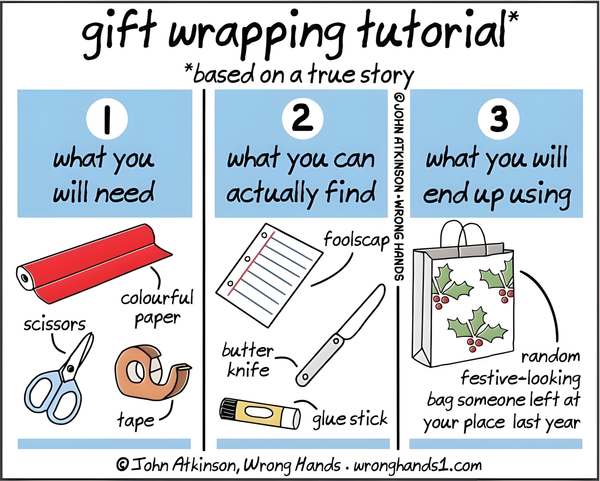The Managers' Guide #112

No, I didn't "forget your name", I didn't store it in the first place, it's called being GDPR compliant.
Lead Forward, Even When the Path Isn’t Clear
- 🌫 When the road disappears, leadership shines — True leadership emerges not when everything’s predictable, but when uncertainty creates chaos. In those moments, leaders succeed not by planning meticulously, but by leaning into clarity, shared purpose, and guiding principles.
- 🧭 Mistaking movement for understanding — In uncertain times, it's common for leaders to confuse being busy with making progress. Rather than waiting for external clarity, great leaders generate internal clarity and
- 🆘 Principles over predictions — Predicting the future is less effective than defining principles that guide decisions. Key principles:
- Clarity instead of certainty
- Results instead of mere activity
- Alignment over perfect agreement
- Action rather than waiting for perfection
- ⚖ Three truths of leading amid uncertainty:
- You don’t need all the answers.
- Confidence is built by taking action—not waiting to feel ready.
- Teams thrive on consistency and purpose, not perfect solutions.
- 🏗 Five tactical steps to lead forward:
- Protect what won’t change — Define non-negotiables (values, promises, leadership standards) and pressure-test them for enduring reliability.
- Prioritize immediate wins over grand plans — Focus on what matters in the next 30 days; test assumptions fast and build momentum through short-term wins.
- Turn mistakes into momentum — Create a quick “Learning Loop”: reflect on what worked, what didn’t, and the next smart move after every key decision or action.
- See faster, adjust faster — Implement rapid feedback cycles, shorter check-ins, real-time accountability, and fast learning rhythms.
- Anchor every step to purpose — Reinforce objective: remind the team why you’re doing this, who benefits, and how it serves the mission. Purpose becomes the compass when clarity fades.
- 🤝 Your behavior sets the tone — When uncertainty clouds the path, people watch how you act—your framing, decisions,, andsteadiness. Clear priorities, principled action, and shared purpose give the team the stability they need.
If Culture Is “Just How We Do Things Around Here,” Then Who’s Doing the Designing?
- 🛋 Surface vs. Substance — The article begins with a story of a leadership team that spent weeks debating office design details like snack bins and ping-pong tables, while neglecting to consider how they were shaping their culture. It shows how many organizations put energy into aesthetics and perks instead of tackling the deeper structures that actually define workplace experience.
- 🔄 Culture as Default, Not Designed — Culture is often treated as something that “just happens,” rather than something to be intentionally built. Left unattended, culture defaults to existing patterns and norms. Employees can feel its presence and effects without being able to name how it operates—or who’s responsible for creating it.
- ⚙ Culture = System, Not Branding — True culture isn’t about glossy branding, slogans, or identity statements. It lives in the systems: how power flows, how decisions get made, who has access to information, and which behaviors are rewarded. These elements shape daily experience, whether they’re consciously designed or not.
- 💡 Intentional Design for Inclusion — To build inclusive, equitable, and effective workplaces, culture must be actively and thoughtfully designed. Leaving it to chance perpetuates inequities and missed opportunities. Designing culture means interrogating systems, distributing power, and ensuring that values are embedded in actual practices.
Reality Check
- 🆘 Fed up with hype — Zitron opens with frustration: despite the chaotic state of the world, tech media continues to push a glossed-over narrative of an "AI revolution" as if everything’s sunshine and rainbows.
- ❓ Where’s the risk talk? — He laments the lack of serious scrutiny regarding OpenAI’s financials, pointing out the company's massive $9 billion spend in 2024 that resulted in a $5 billion loss.
- 📈 Bizarre revenue projections — Zitron highlights forecasts that OpenAI will reach $125 billion in revenue by 2029, largely through speculative products like AI "agents" and monetizing free users — projections he calls absurd and unsupported.
- 💰 SoftBank bet shaky — A key assumption is that SoftBank will contribute $3 billion a year via its vague "Cristal Intelligence" project — Zitron doubts this is realistic and warns it's far from a guaranteed win.
- 🆚 Cost versus profit turmoil — He breaks down how OpenAI’s subscription revenue (around $8 billion in 2025 projections) could be largely eaten up by surging AI inference costs, expected to hit $6 billion this year alone.
- 🤯 User numbers feel fishy — Claims of 500 million weekly users, or even more, strike Zitron as questionable. He suspects overstatement or marketing spin, not verified engagement.
- 💣 Generative AI bubble warning — Zitron bluntly compares generative AI hype to bubble dynamics: high expectations, shaky economics, cost-intensive infrastructure, and scarce profitability beyond Nvidia.
- 🧐 Google vs ChatGPT — He suggests ChatGPT's popularity stems partly from Google Search's decay rather than superior utility. Users flock to ChatGPT because Google’s search experience has become cluttered and ad-heavy, not because AI is inherently transformative.
- 🤔 No AGI in sight — Zitron underscores that none of OpenAI or Anthropic’s outputs signals AGI. Even the discourse around AI "consciousness" is marketing dressed as progress, with little substance.
- ⏳ Economy of hype draining — Finally, he warns the tech economy is overly reliant on growth-at-all-costs narratives. Once enthusiasm fades and fundamentals sink in, the fallout could be far-reaching — not just for AI, but for valuations across the tech sector.
Systems Ideas that Sound Good But Almost Never Work
- 🔌 “Let’s just make it pluggable” — Swappable components sound elegant, but true pluggability only works if multiple implementations are built at the same time—otherwise, it rarely “just works.”
- 📡 “Let’s just add an API” — APIs seem simple, but being a reliable platform requires long-term commitment. They lock in constraints, demand careful upkeep, and don’t guarantee adoption.
- 🌀 “Let’s abstract that one more time” — Abstractions can help, but when added too early or without real need, they bloat systems, slow performance, and complicate maintenance.
- ⏳ “Let’s make that asynchronous” — Async promises responsiveness, but without solid frameworks it introduces subtle bugs and even risks data corruption.
- 🔒 “Let’s just add access controls later” — Security can’t be bolted on after the fact. Deferring it almost always causes flawed designs or painful rewrites.
- 🔄 “Let’s just sync the data” — Data sync is notoriously hard. It sounds simple but requires deep expertise—most attempts end up fragile or broken.
- 🌐 “Let’s make it cross-platform” — Supporting multiple platforms feels wise, but complexity explodes. It’s practically like building an OS or browser—most efforts collapse under the weight.
- 🛠️ “Let’s enable escape to native” — Letting apps drop down to native code offers flexibility, but it often breaks internal state and caching, introducing bigger risks than benefits.
How To Get Good at Strategy
- 🎯 Set Clear, Strategic Goals — Define your purpose first. Whether it’s scaling, empowering, or problem-solving, a solid strategy begins with why.
- 🕸️ Think Systems, Not Checklists — Strategy isn’t about doing more—it’s about coherence. Build frameworks that connect decisions to outcomes.
- ⏱️ Balance Speed with Reflection — Move fast, but pause to review. Strong strategies evolve through cycles of action, learning, and refinement.
- 🔗 Link Vision to Execution — A big vision only works if it translates into clear priorities, ownership, and action.
- 👂 Use Feedback—Not Ego—as Compass — Great strategists listen, test assumptions, and adjust instead of clinging to pride.
- ✅ Embed Accountability Throughout — Assign clear responsibilities and timelines so strategy becomes real, not just theory.
That’s all for this week’s edition
I hope you liked it, and you’ve learned something — if you did, don’t forget to give a thumbs-up, add your thoughts as comments, and share this issue with your friends and network.
See you all next week 👋
Oh, and if someone forwarded this email to you, sign up if you found it useful 👇



